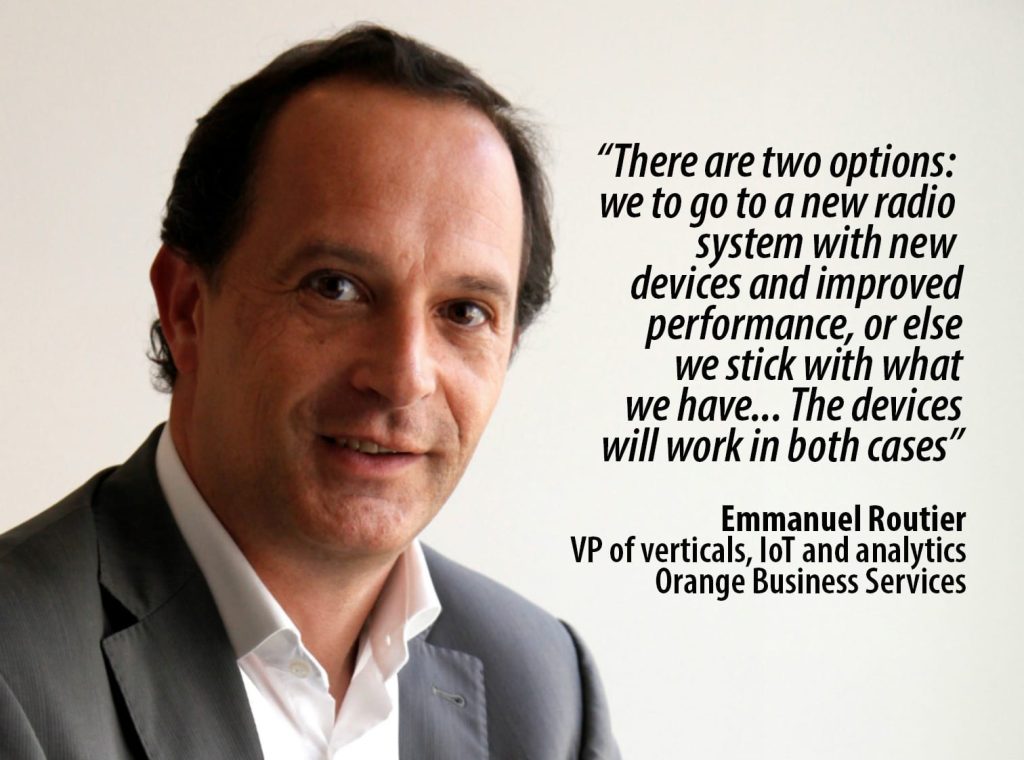Note, this article is continued from a previous post, entitled “Orange on IoT: ‘We’re different; we take innovation to the customer’”. Click here to go to the previous article.
The role of Orange Business Services as a “carrier-grade systems integrator” might sound familiar (see previous article), but its impartiality on network technologies looks more pronounced. The French brand is a fierce champion of LoRaWAN, for instance.
It has 95 per cent of the population of France covered, alongside most of Slovakia and Romania, notes Emmanuel Routier, the company’s vice president of verticals, IoT and analytics, in interview with Enterprise IoT Insights at MWC 2019, back at the end of February.
LoRaWAN is the cheapest and simplest solution for static machines and sensors in the field, without a power supply to them, he says – and, for the record, way more cost effective than its cellular low-power wide-area (LPWA) equivalents, in the form of LTE-M and NB-IoT.
“It is very cheap because it is very simple, and very efficient in terms of energy usage – and it will be cheaper than NB-IoT and LTE-M even in the future,” says Routier.
It is a notable assertion, which should be taken as gospel: afterall, this is a cellular operator with costly spectrum holdings, recommending that enterprises make use non-cellular tech in unlicensed spectrum.
“There are use cases that fit very well with LoRa,” he says. Orange has signed about the biggest European LPWA deal in the history, with over three million water meters to be connected to its LoRaWAN network in France.
The deal is between Orange Business Services and IoT outfit Birdz, a subsidiary of Nova Veolia, the digital services business of French water company Veolia, which was formed out of the merger of Homerider Systems and m2ocity. “We provde the best technology in terms of deep indoor coverage and power consumption,” says Routier.

LoRaWAN effectively works for Orange in place of NB-IoT; it is for static objects, in out-of-reach locales. It has only deployed NB-IoT in Belgium – and there, only, to keep its eye in. “Because who knows what will happen in the future. You know, this stuff is evolving.”
For LPWA tracking, Orange has fallen in with LTE-M, instead. Its European operations have been optimised for LTE-M already. “We’re done in France and Belgium, and we have big deployments in Spain, Poland, Romania.” LTE-M works in concert with its single NB-IoT showing in Romania, and its three-way LoRaWAN network, he says.
We push him, again, on the question of cellular versus non-cellular LPWA tech. Doesn’t Orange’s LTE-M footprint negate its LoRaWAN offer – because LTE-M is a global standard, in your blood, and your setup is supported by a myriad of easy roaming agreements?
“Yes, but for energy performance, for certain use cases, LoRa makes sense, whether nationwide or in a specific location,” responds Routier. LoRaWAN offers global scale, as well, he points out. “We can deploy in 35 countries, in certain locations, without a licence – just on-premise, on the shop floor.”
As above, the difference is in the mobility of the two. “That’s right; these roaming agreements in Europe, Asia, and the Americas are important”. Where mobility is required, as with tracking solutions, LTE-M is the only option; for fix-and-forget applications, LoRaWAN is the only game in town, he implies.
Routier describes the development of low-power IoT technologies like LTE-M and NB-IoT in the 5G era as a “natural evolution” from their start-point as a function of today’s LTE networks. They will be superseded by the Release 16 specification for massive machine-type communications (mMTC), or ‘massive IoT’, after 2022.
“There are two options: either there’s a need to go to massive IoT for a new radio system – which implies new devices, and improved performance, compared to what we have today in the radio system with LTE-M and NB-IoT – or else we stick with what we have,” he explains.
For enterprises, existing LPWA systems will continue to function; the question will only be whether the case to upgrade devices to a new radio (NR) interface makes sense. “The two radio systems will be supported in the same spectrum, which means we don’t have to refarm frequencies. It’s an evolution.”
Enterprises can afford to wait, he says, before pacing their bets on 5G-era IoT technologies. “If there’s no significant improvement in the radio, then we’ll just keep the same system; we’ll see, in two years,” he says.
“The devices will work anyway, in both cases. Either there’s an improvement, and you have two types of device, running on the old radio and the new radio, or you just keep the existing radio system, but on the 5G core network – where only the core changes.”
He adds: “The message is: keep your investment. Better-performing devices will be available, but they might not be required. New use cases will emerge, which you can invest in. But you will be able to keep these IoT devices.
“The point is you can go already, now [with 5G]. It’s pre-massive IoT, with LTE-M and NB-IoT, but it’s in the standard. Your investment will be safe.”
This article continues here. Sign up to the newsletter to get all the latest updates from Enterprise IoT Insights.
Orange on IoT: “We’re different; we take innovation to the customer”
Orange on LPWA: “If there’s no improvement in the radio, we’ll keep the same system”
Orange on URLLC (and private 5G): “The economics favour public networks”
